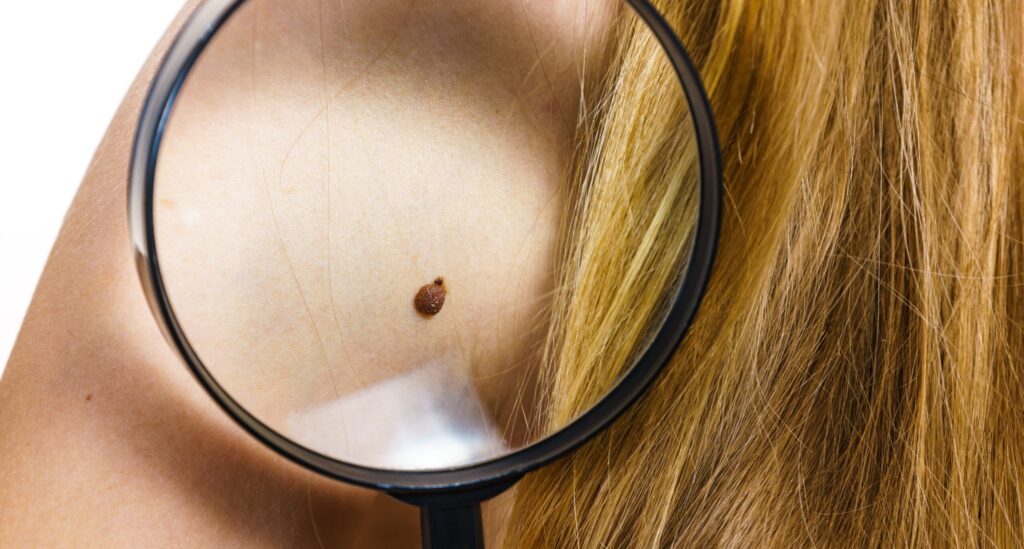What is Mole Mapping?
Mole mapping is a specialized approach used to monitor and document moles (nevi) on the skin over time. “This process helps in the early detection of skin cancers, particularly melanoma, which can develop from existing moles or appear as new growths on the skin,” explains Dr. Adam Mamelak, Canadian and American Dermatologist and skin cancer specialist. By systematically tracking changes in moles, dermatologists can identify suspicious alterations that might indicate malignancy.
Methods of Mole Mapping
Traditional Photography
The traditional approach to mole mapping involves taking high-resolution photographs of a patient’s entire skin surface. These images are stored and compared during follow-up visits to detect any changes in size, shape, color, or texture of the moles. “These photographic records provide a visual baseline, making it easier to spot new moles or alterations in existing ones,” says Dr. Mamelak.
Dermoscopy
Dermoscopy is another vital technique used in conjunction with photography. This non-invasive method uses a handheld specialized magnifying tool or microscope, to examine the structures and patterns of moles. Dermoscopic images offer greater detail than the naked eye, revealing subsurface features that are crucial for accurate assessment.
Mobile Apps and Digital Platforms
With advancements in technology, several mobile apps and digital platforms have been developed to facilitate mole mapping. These apps allow users to take photographs of their moles and track changes over time. Some popular mole mapping apps include:
- Miiskin: Enables users to take photos and compare them over time.
- SkinVision: Uses algorithms to assess mole risk based on images uploaded by the user.
- MoleMapper: Allows users to map moles and track their evolution using their smartphone.
Artificial Intelligence (AI)
The latest frontier in mole mapping incorporates artificial intelligence to enhance accuracy and efficiency. AI algorithms analyze images of moles, comparing them against vast databases of known mole characteristics. This helps in identifying patterns and anomalies that might be indicative of skin cancer. AI-driven platforms can provide preliminary assessments, flagging moles that require further examination by a dermatologist.
Who Benefits Most from Mole Mapping?
While mole mapping can be beneficial for anyone, certain individuals are at higher risk for skin cancer and can particularly benefit from regular monitoring:
- People with Numerous Moles: Those with a high number of moles are at increased risk for melanoma.
- Individuals with Dysplastic Nevi: Atypical moles with an different appearance from common moles and have a higher likelihood of developing into melanoma.
- Family History of Skin Cancer: Individuals with a family history of melanoma or other skin cancers.
- Fair Skin: People with lighter skin that burns easily.
- History of Sunburns: Those who have experienced severe sunburns, especially during childhood.
Early Detection of Skin Cancer
Early detection is crucial in the successful treatment of skin cancer. Mole mapping plays a pivotal role in this regard:
- Baseline Documentation: Establishing a baseline with detailed images allows for the detection of new or changing moles.
- Regular Monitoring: Periodic comparisons help in identifying subtle changes that may not be noticeable to the naked eye.
- Prompt Action: Detecting suspicious changes early enables timely biopsies and interventions, which can significantly improve treatment outcomes.
AI in Mole Mapping: A New Era
Artificial intelligence is revolutionizing mole mapping by enhancing diagnostic precision. “Many of these applications out perform primary care doctors and perform en par with dermatologists in differentiating benign and malignant skin lesions,” says Dr. Mamelak. Here’s how AI is making a difference:
- Automated Analysis: AI algorithms can swiftly analyze images, reducing the time required for assessment and increasing the throughput of screenings.
- Enhanced Accuracy: By learning from vast datasets, AI can identify malignancies with a high degree of accuracy, sometimes even outperforming human dermatologists in detecting early-stage cancers.
- Continuous Improvement: AI systems continuously improve as they process more data, refining their diagnostic capabilities over time.
Conclusion
Mole mapping is an invaluable tool in the fight against skin cancer. Through methods like traditional photography, dermoscopy, and advanced digital apps, individuals can effectively monitor their moles and detect early signs of skin changes. The incorporation of artificial intelligence into mole mapping marks a significant leap forward, offering enhanced accuracy and efficiency in screening for skin cancer. For those at higher risk, regular mole mapping can be a life-saving practice, ensuring timely detection and treatment of skin cancer.

